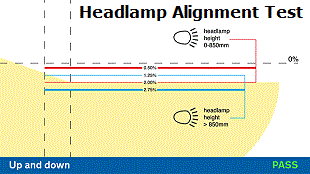HEADLAMP ALIGNMENT: The typical ‘quick check’ performed at most testing stations for correct headlamp aim is gone.
You will now see big changes as a result of this year’s Ministry of Transport (MOT) modernisation.
They are part of the new Driver and Vehicle Standards Agency (DVSA) laws in the United Kingdom.
The Vehicle Testing Station (VTS) council member volunteers trialled and oversaw the results. They were then verified at Loughborough University by the Vehicle Safety Research Centre.
The changes are akin to those introduced for Heavy Goods Vehicles (HGV) in 2015. There have been significant decreases in the test failure rates since then.
Why Change MOT Headlamp Rules?
The main reasons for the changes seem to relate most to the testers themselves. MOT inspectors have proved to show inconsistency in the accuracy of their assessments of headlamp aim. That is according to an MOT compliance survey.
New headlamp alignment changes aim to reduce test errors. They should increase the general consistency of annual vehicle safety checks. The MOT modernization widens the tolerance band for European ‘E’ beams with headlamp centers up to 850mm.
They have also introduced an amended requirement to test the ‘image break‘ point for all European ‘E‘ beams.
1. Headlamp Horizontal Cut-off
 Methods for checking the aim of the horizontal cut-off remain unchanged. But, the lower limit for headlamps (up to 850mm) has changed to 2.75% (2.0% before).
Methods for checking the aim of the horizontal cut-off remain unchanged. But, the lower limit for headlamps (up to 850mm) has changed to 2.75% (2.0% before).
A headlamp will now fail if its horizontal cut-off is:
- Above the upper limit of 0.5%
- Below the lower limit of 2.75%
2. Headlight Dazzle Zone
UK MOT testing rules in the past needed to find the ‘image break point’.
It had to check that its alignment complied with a small margin of the headlamp beam tester screen. Headlamps would fail the test if the ‘break point’ was outside of this small box. Testers will not need to check that any longer from the 24th of March 2016.
The new method checks for ‘white light‘ in the area formed by the 0% vertical and the 0.5% horizontal lines for all European ‘E’ beams. They call it the ‘dazzle zone’ because the beam is likely to dazzle oncoming vehicles if it gets aimed in this area.
Note: White light falling into this mark would result in the headlamp failing the test on that occasion.
3. Visible Kick up
The final part of the headlamp accuracy test is ensuring that there is a ‘kick up‘ visible on the screen (where required). Not all vehicle headlamps have kick ups. Some lights have flat tops and some get fitted with beam deflectors. In simple terms, if a kick up is required, the unit only fails the test if it does not show up on the screen.
MOT Inspection Manuals
Ministry of Transport inspection manuals will get updated accordingly. They will include the new testing standards of headlamp alignment and dazzle for driving accuracy and safety in the United Kingdom.
ALSO IN THIS SECTION
Articles about Homes and Family Life: News stories about rules for home and lifestyle regulations.
British Transport Competition: Autonomous Vehicle Technology companies compete to win £30 million.
Driving Test Rules: DVSA unveil a handful of changes to the car practical driving test.
Motorway Lessons for Learners: Motorway driving instruction part of learning to drive a car from 2018.
Splashing Pedestrian Laws: Cars splashing pedestrians with puddles is illegal in the United Kingdom.
Traffic Sign Regulations: DfT launch the new Traffic Signs Regulations and General Directions.

